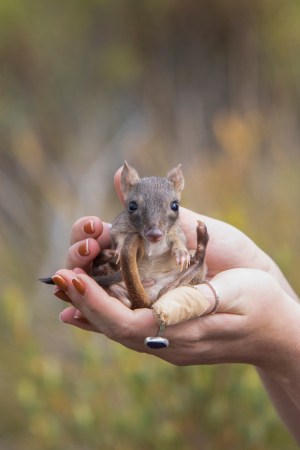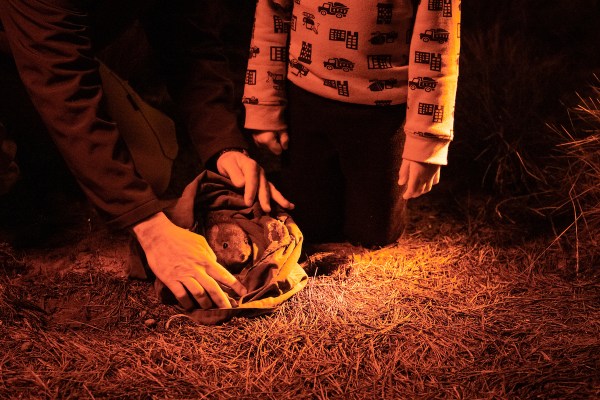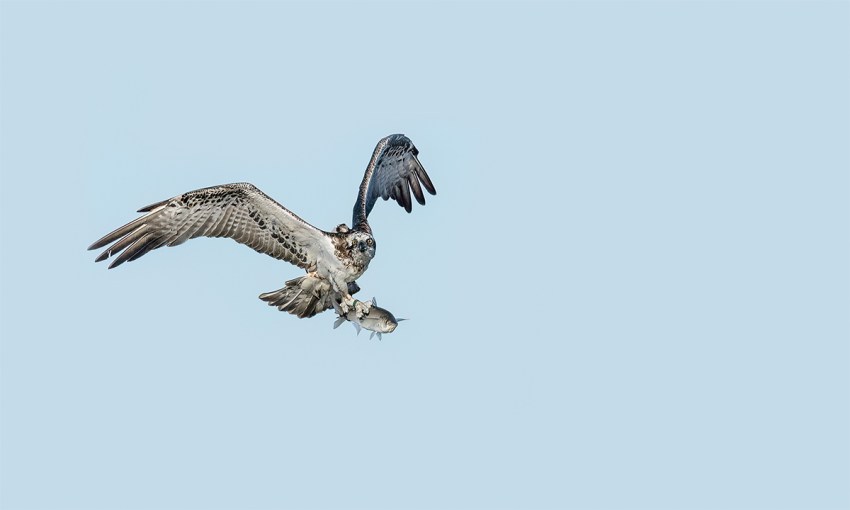On the southern Yorke Peninsula, two endangered species – a soil-engineering marsupial and a majestic coastal predator – are thriving against the odds thanks to people power and ground-breaking conservation efforts that are turning the tide against extinction.
Back from the brink
At Coobowie, a small town near the south-eastern tip of Yorke Peninsula, two majestic eastern ospreys can be seen making spectacular dive-bombs for fish, coasting about the estuary and roosting on their nest, which sits on a tall artificial platform perched over the ocean.
The tower is just one of 14 that have been installed across South Australia in the past three years, many of them situated on Yorke Peninsula. The community-led project has seen the 500-kilogram tower constructed by the Ardrossan Community and Men’s Shed, with a nest assembled by Yorketown Area School students, and helicoptered into position with the assistance of volunteers from Friends of Osprey.
Another four towers are to be installed across the state in 2024. It has created a promising future for the eastern osprey considering that just seven years ago, their future looked grim. Before the towers were put up, the birds were no longer breeding on Yorke Peninsula.

In 2017, dedicated Yorke Peninsula bird enthusiast, the late Kent Treloar heard about an osprey pair nesting in a risky location atop a navigation beacon. Kent came up with the idea of installing a makeshift artificial platform in the nearby mangrove trees to lure the birds into a more appropriate spot – and it worked.
Since then, the Southern Yorke Peninsula Landcare Group has championed the cause, with support from Friends of Osprey. Sensitive to human disturbance and fox predation, the ospreys greatly benefitted from the safe, elevated nesting platforms.
Friends of Osprey president Ian Falkenberg says eastern osprey numbers have declined by a quarter in just the past 15 years to the point there are less than 50 breeding pairs left in South Australia.
“A combination of people disturbance and fox predation has played a big role in some of these nesting sites, as well as storms, and also pacific gulls and ravens that rob nests,” says Ian.

“Six years ago, there was only one active nest on all of Yorke Peninsula, and now we have six. Not only are they occupied, but they’re producing young. At Gleeson’s Landing, last year was the first time in 12 years they have produced their own young.
“It was certainly a shot in the dark, but one that proved to be successful.”
Ian has been a key driver of the project. As part of the state-wide program, he has been involved fitting solar-powered satellite trackers to the endangered ospreys for the first time in Australia.
The Coobowie platform was installed after a pair of ospreys had built a nest in a precarious position atop a phone tower at Edithburgh. Within four hours of the new platform being installed, the ospreys flew across from the phone tower and began taking up residence on the new nest. They have been there ever since.

Coobowie and Gleeson’s Landing are the easiest locations for the public to view the ospreys on Yorke Peninsula. While the Coobowie ospreys unfortunately did not hatch their eggs this summer, the pair at Gleeson’s Landing are now raising one chick on their artificial nest.
Ian says February is a great time of year to see the birds foraging and hunting. The Coobowie location includes a hide where bird watchers can observe the ospreys without disturbing them.
“These birds are at their most spectacular when you see them dive almost vertically into the water to catch fish. It’s just extraordinary and something you’ll never forget,” says Ian. “It’s a great location here at Coobowie. I think that with community awareness, if people are sensible and keep their distance, then these birds and humans can coexist.”
The brush-tailed bettong once inhabited more than half of mainland Australia. Known as yalgiri to the Narungga people of Yorke Peninsula, the cute marsupial is a key ecosystem engineer, digging burrows and turning over tonnes of soil each year, allowing vegetation and other animals to flourish – a farmer of the bush.

The bettong became locally extinct on Yorke Peninsula more than 100 years ago, wiped out by habitat destruction and introduced predators. In the 1980s, it came close to nation-wide extinction.
Yet remarkably, just as visitors to southern Yorke Peninsula this summer might witness the spectacular dive-hunting displays of ospreys, those camping in and around Dhilba Guuranda-Innes National Park may be lucky to spot a nocturnal bettong scurrying about the bush after dark.
The return of these two native species that were otherwise headed for extinction is thanks to ground-breaking new conservation projects, driven by passionate local people.

The re-introduction of the bettong is part of an ambitious project dubbed Marna Banggara – meaning healthy country – the first project in Australia to apply rewilding principles in a working landscape where conservation, agriculture and the community exist side-by-side. Unlike other sanctuaries, it is not completely free of introduced predators and other pests.
Marna Banggara is overseen by the Northern and Yorke Landscape Board and jointly funded and supported through the state and federal governments, Zoos SA and WWF-Australia, and the Narungga Nation Aboriginal Corporation. It will investigate if the reintroduction of key native species can restore the wider ecosystem and provide flow-on benefits to agriculture.
In 2019, a predator control fence was erected across the foot of the peninsula – from one coast to the other – creating a 140,000-hectare conservation zone. While not all foxes and cats can be eliminated, the fence and other control methods have enabled effective pest management that has prepared the land for the return of locally extinct native species.
Since 2021, almost 200 brush-tailed bettongs have been translocated from Wedge Island in the Spencer Gulf and from Western Australia.
Late last year, a monitoring team spent four weeks capturing and releasing bettongs to check on the progress of the population. They caught 143 animals – more than half of which had been born on the peninsula – and 95 per cent of females captured were carrying pouch young.

Northern and Yorke Landscape Board project manager Derek Sandow leads the monitoring effort, which involves trekking across several kilometres in the early mornings to check and re-set traps. Balls of peanut butter and oats prove irresistible to the yalgiri.
“The results have been fantastic and show the population really has been flourishing,” says Derek.
“We’re finding a good mix of all the different cohorts we’ve translocated, and the health of the animals is positive. The numbers that we’re catching indicate that the population has grown.
“We take body and weight measurements, look at their condition and check for ticks and fleas, and note if the females are carrying pouched young. I’m optimistic that over the next five years we’ll be looking at getting other species on the ground. The project has a very bright future.”

The next candidates for reintroduction include the southern brown bandicoot, with long-term hopes to eventually introduce a natural predator such as the western quoll. “A single bettong can turn over between two and six tonnes of soil a year. By digging in the soil, they’re aerating it, creating little pits where seeds and water can collect, micro habitats, and that’s one of the functions that has gone missing from the landscape,” says Derek.
“Tilling the soil like little farmers, they’re helping the bush to remain diverse, creating habitat for other native animals. This project is about healthy biodiversity, which can benefit the local economy, tourism and farmers,” says Derek.
Derek says Dhilba Guuranda-Innes National Park is the best place to try and see the nocturnal bettongs in the wild, while he urges visitors to abide speed limits, especially at night. “People camping at Inneston and Pondalowie have seen them [bettongs] around campsites after dark,” he says.
“They’re the two places I’d suggest finding them. Early evening and during the night, if you get out and about with your head torch, you just never know.”
This article first appeared in the February 2024 issue of SALIFE magazine.



